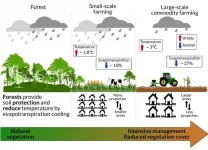(Press-News.org) As teens' use of social media has grown over the past decade, so too has the suicide rate among younger people, with suicide now being the second leading cause of death among those ages 10 to 34. Many have suggested that social media is driving the increased suicide risk, but because social media is still relatively new, it's been difficult to determine its long-term effects on mental health.
In the longest study to date on social media use and suicidality, BYU research recently published in the Journal of Youth and Adolescence now offers some answers.
Through annual surveys from 2009 to 2019, researchers tracked the media use patterns and mental health of 500 teens as part of the Flourishing Families Project. They found that while social media use had little effect on boys' suicidality risk, for girls there was a tipping point. Girls who used social media for at least two to three hours per day at the beginning of the study--when they were about 13 years old--and then greatly increased their use over time were at a higher clinical risk for suicide as emerging adults.
"Something about that specific social media use pattern is particularly harmful for young girls," said BYU professor Sarah Coyne, the lead author of the study. She noted that girls' social tendencies likely make them more susceptible to the negative effects of social media.
"Research shows that girls and women in general are very relationally attuned and sensitive to interpersonal stressors, and social media is all about relationships," Coyne explained. "At 13, girls are just starting to be ready to handle the darker underbelly of social media, such as FOMO (fear of missing out), constant comparisons and cyberbullying. A 13-year-old is probably not developmentally ready for three hours of social media a day."
That said, in most cases Coyne doesn't recommend parents ban teenage daughters from social media, which can backfire by leaving them poorly prepared to manage their media use as adults.
"Thirteen is not a bad age to begin social media," said Coyne, whose own 13-year-old daughter just joined TikTok. "But it should start at a really low level and should be appropriately managed."
Coyne suggests that parents limit young teens' social media time to about 20 minutes a day, maintain access to their accounts and talk with teens frequently about what they're seeing on social media. Over time, teens can gradually scale up their social media use and autonomy.
"The goal is to teach them to be healthy users of social media, to use it in a way that helps them feel good about themselves and connect with other people, which is its real purpose. It's parents' job to scaffold or pre-arm children so that they can deal with some of the heavy stuff that often comes with using social media."
For young adults who feel they've already developed suboptimal social media habits, Coyne is optimistic that they can make a change. As her previous research has shown, social media can be a positive experience for teens and people of any age if they use it well.
Good habits include logging on for a purpose and actively participating rather than passively scrolling, as well as unfollowing those who are exclusionary or have a negative influence.
"I would love for every BYU student to be mindful about the ways they're using social media, how it's working for their mental health and how it's harming their mental health. And then just to avoid doing those harmful things, whatever they are," said Coyne. "I think that could have a significant impact on our community."
INFORMATION:
The study was co-authored by current and former BYU professors and students, including Jeffrey L. Hurst, W. Justin Dyer, Quintin Hunt, Emily Schvaneveldt, Sara Brown and Gavin Jones.
For more tips on healthy social media use, see Professor Coyne's social media curriculum.
Are you struggling with suicidal thoughts or do you know someone who is? Contact the National Suicide Prevention Hotline.
One of the dozens of unusual symptoms that have emerged in COVID-19 patients is a condition that's informally called "COVID brain" or "brain fog." It's characterized by confusion, headaches, and loss of short-term memory. In severe cases, it can lead to psychosis and even seizures. It usually emerges weeks after someone first becomes sick with COVID-19.
In the February 8, 2021, issue of the journal Cancer Cell, a multidisciplinary team from Memorial Sloan Kettering reports an underlying cause of COVID brain: the presence of inflammatory molecules in the liquid surrounding the brain and spinal cord (called the cerebrospinal fluid). The findings suggest that anti-inflammatory drugs, such as steroids, may ...
Exposure to sexual assault in the U.S. military doubled the odds that a service member would leave the military within 28 months, and sexual harassment was associated with roughly 8% of all military separations during this same time period, according to a new report from the RAND Corporation.
Specifically, the report estimates that sexual assaults were associated with 2,000 more separations than would normally be expected, and another 8,000 separations were associated with sexual harassment.
"Sexual assault and sexual harassment are associated with a wide range of harms to individual service members, but this study highlights another negative impact of these crimes - higher rates of attrition and associated harms to force readiness." said Andrew ...
The world is changing rapidly and in order to serve the human population dealing with those changes, American universities need to change, too. In fact, their role is to model the resiliency that all institutions need to embrace, according to Arizona State University President Michael M. Crow.
While many leading universities are poised to advance society and help respond to the challenges of disruptive change through their traditional role in education and discovery, many face a number of barriers that make them less prepared to respond to the rapidly changing conditions and the demands they create.
What is emerging is a new type of university, one that steps beyond the American research university model and ...
Not all friendships are created equal. Some friends get along; others struggle to avoid conflict. Conventional wisdom holds that the tenor of a friendship with someone who is nice differs from that with someone who is mean, such that the former discourages negative interactions whereas the latter aggravates them. Although it is logical to assume that children who are mean have friendships characterized by growing strife and that children who are nice report little of the same, these assumptions have not yet been tested in the real-world friendships of children.
Researchers from Florida Atlantic University's Charles E. Schmidt College of Science are the first to conduct a longitudinal study to examine the extent to which being "nice" (prosocial behavior) and being "mean" (relationally aggressive ...
A new study from University of Alberta researchers has shown that traumatic or stressful events in childhood may lead to tiny changes in key brain structures that can now be identified decades later.
The study is the first to show that trauma or maltreatment during a child's early years--a well-known risk factor for developing mental health conditions such as major depressive disorder in adulthood--triggers changes in specific subregions of the amygdala and the hippocampus.
Once these changes occur, researchers believe the affected regions of the brain may not function as well, potentially increasing the risk of developing mental health disorders as adults during times of stress.
"Now ...
CORVALLIS, Ore. - Marching band members in leadership roles are more likely to feel discomfort in the neck and upper back than their less experienced bandmates, who in turn are more susceptible to left-hand pain and cognitive strain, a new study by Oregon State University suggests.
The findings also showed that gender had no bearing on how much discomfort a musician felt or the band member's perception of workload.
"The study really seems to indicate that a player's level of experience and role within the band are what drive how much discomfort they feel," said industrial ...
Neurons are the primary cells of the nervous system, and the signals that are transmitted between them are responsible for all our actions and our cognitive ability. In particular, learning and memory are believed to be associated with a process called "long-term potentiation," which is the strengthening of connections between specific neurons via continued signal transmission through "synapses" (small gaps between neurons). Long-term potentiation can change the connection between neurons via synapses--by changing their size and composition. Understanding ...
Researchers report that large-scale commercial farms on deforested land in the southern Amazon result in higher temperature increases and less rainfall than small-scale farms.
Deforestation has converted swaths of land in the southern Amazon region from rainforest to farmland. The uses of the deforested land are diverse, and activities can range from small-scale farming in rural settlements to large-scale commodity agriculture. Commercial farms in the Southern Amazon can reach hundreds of thousands of hectares in area, exporting millions of tons in grains and beef every year.
Eduardo Maeda from the University of Helsinki and colleagues used satellite data to compare areas dominated by different land uses and farm sizes to evaluate their impacts on ...
Li-ion batteries (LIBs) are widely used in various mobile electronics. Concerns of global warming and climate change have recently boosted the demand for LIBs in electric vehicles and solar photovoltaic output smoothing. Si has been studied as an active material with a high theoretical capacity of 3578 mAh/g, which is around ten times higher than that of graphite (372 mAh/g).
Now, a team of researchers at Osaka University has used flake-shaped Si nanopowder wrapped by ultrathin graphite sheets (GSs) to fabricate LIB electrodes with high areal capacity and current density.
Generally ...
Rivers and lakes at high latitudes are considered to be major sources for greenhouse gas emissions to the atmosphere, but these losses are poorly constrained. In a study published in Nature Communications, Umeå University researchers and collaborators quantify carbon emissions from rivers and lakes across Western Siberia, finding that emission are high and exceed carbon export to the Arctic Ocean.
High latitude regions play a key role in the global carbon cycle and climate system. An important question is the degree of mobilization and atmospheric release of vast soil carbon stocks, partly stored in permafrost, with amplified warming of these regions. A fraction of this carbon is exported to inland waters and emitted to the atmosphere, yet these ...





